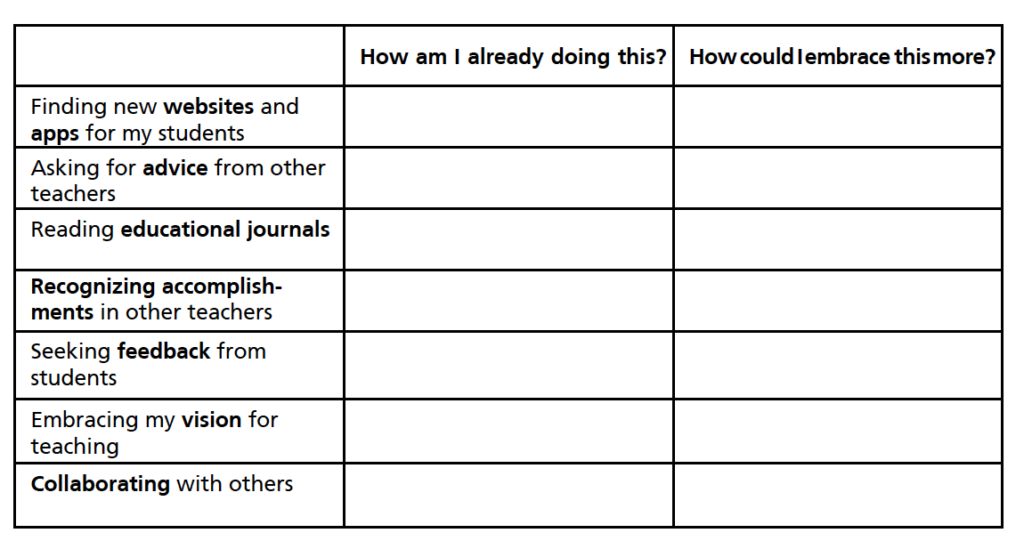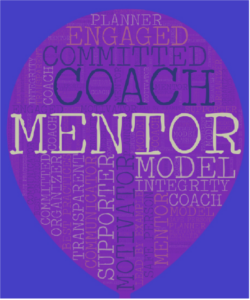Voices from the Field: What does it Mean to be a Teacher Leader?
by Diana Helwig, Bettie Nickerson, Dr. Mary Palmer Legare, Tamara Reynolds, and Vicky Routson
Introduction
The term “teacher leader” carries with it a wide range of meanings, responsibilities, and roles that can change from situation to situation, or even moment to moment. The professional learning association Learning Forward widely defines the term as “a set of practices that enhances the teaching profession” but adds that this definition is still too limiting. In this section, adult education teachers across the state share their experiences in teacher leadership and what the term means to them (Killion, et. al., 2016). The teachers are members of a virtual learning community, facilitated by Hillary Major and Dr. Kate Daly Rolander at the Virginia Adult Learning Resource Center, who share their practices to build on each other’s knowledge and experiences and to work to move the field of adult education forward through collaboration and innovation. In writing this article, we hope to expand our sharing beyond our virtual group and extend discussions around what it means to be a teacher leader to other instructors around the state.
We Are All Students
Betty Nickerson, GED® Instructor, Region 19, Southside Programs for Adult Continuing Education (SPACE) Surry County Resource and Employment Center
While researching teacher leadership, I kept coming across the repeating themes of collaboration and mentorship. As I thought about these, it occurred to me that the teacher leader needs to be a student as well. In this ever-changing landscape, teachers need to be reeducating themselves on a continual basis. After taking a 15-year detour from adult education, I was overwhelmed by what I needed to know and be able to do as I reentered the classroom in 2018. It wasn’t the content areas as much as it was technology. Almost every aspect of adult education is touched by technology, even more so as our classes are affected by the closings resulting from the COVID-19 pandemic. This pandemic pushes us into distance learning with our students. Many teacher leaders at the local and state levels have provided us with a multitude of resources. So here is our chance to try some of the resources that we may not be adept at using. Some may work better for others and are not one-size-fits-all. This does, however, give us the opportunity to motivate and inspire our students as they witness us in the role of a student. It certainly reinforces learning as a lifelong process.
“Our efforts to grow as teacher leaders will help us empower ourselves, other teachers, and our students!”
Foundations of Support & Sharing
Vicky Routson, Adult English Language Learner Teacher, Region 8, Loudon County
For me, teacher leadership starts with creating a foundation of support and sharing within my cohort of teachers. In my experience, many adult ELL teachers have busy lives, full-time day jobs, and just don’t have the time to seek out opportunities to connect and share, even with other teachers at their sites. My initial response to this has been to try to coordinate group events at the end of each thirteen-week session. Group potlucks where the teachers from all classrooms participate along with their students is a great way to get communication going between staff members. It seems that the more the teachers connect even via email, the more comfortable they are in reaching out for help, sharing out resources, and communicating with the group at large.
Leadership & Learning
Diana Helwig, Adult ESL Instructor, Region 19, Southside Programs for Adult Continuing Education (SPACE) Prince George County
President John F. Kennedy said, “Leadership and learning are indispensable to each other.” This combination of leadership and learning is what we need in teacher leaders—teachers who continually strive to discover and apply new research-based knowledge. Every person has the potential to show leadership, and teachers have a unique opportunity to lead students, other teachers, and anyone who is watching. So, how do we become the best possible teacher leaders? We follow the same guidance that we give our students: set small goals and work daily to achieve them so that our educational community can continue to improve for the sake of our students.
- Take risks to find and use new educational technology sources.
- Ask for advice from other teachers.
- Read educational journals (like PROGRESS).
- Recognize the accomplishments of other teachers to encourage them and learn from them.
- Seek feedback from our students about what’s working, what’s not, and what they are missing.
- Focus on and embrace our vision of why we teach.
- Collaborate with others to build a team and inspire each other.
Our efforts to grow as teacher leaders will help us empower ourselves, other teachers, and our students!
Use this chart to guide your reflections on your role as a teacher leader:
 See some examples of Diana’s work to:
See some examples of Diana’s work to:
- survey students about distance education options;
- organize English Language PLCs through detailed agendas (see Agenda 1 and Agenda 2); and
- make the English Language Proficiency Standards easily accessible for instructional planning and for scoring.
Teacher Leadership in Cyberspace
Mary Palmer, Ph.D, Adult Education Instructor, Region 17, Rappahannock Community College
How does one exercise teacher leadership when we as teachers so rarely see each other? We are spread out over several different campuses across five counties. All of our professional development sessions are led by teachers; however, we have only three each year, which last three hours each and give us a total of only nine hours of time spent together learning.
I know from my years of experience in public and private schools that professional development with no plans for follow-up amongst teachers may give us an idea or two, but it is unlikely to effect the kind of change in practices and grounding theory that promotes real professional growth. These ideas may spice up the soup, but rarely is the recipe upgraded.
We are lucky to have a team of fantastic and dedicated part-time teachers. Our team is made up of people who work at full-time time or other part-time jobs, as well as people who have retired. We have some teachers who have many years of experience and some with less experience. We have some ‘lifelong learners‘ who maintain a constant state of professional self-study through their own reading and research. We have some bright and capable instructors whose degrees are in areas other than education and who are learning on their feet. We have some teachers who have never been in the classroom before. Many teachers fall into one or more of these categories, but what is clear to me is that their professional development needs vary widely. How can we as teacher leaders provide more flexibility in our professional development offerings? I believe that remote learning holds some answers.
In my foray into setting up remote classes and communication systems for my students during this time of pandemic shutdowns, I have found that there is tremendous flexibility in how students make use of the resources I have set up. Some prefer just chatting through messaging; some want video chats, group or individual; some need the common visual of screen-sharing. Some crave community, but some want strictly one-on-one. Remote learning provides all of these options.
The richest and most productive parts of my own professional learning experience have always involved teacher-to-teacher support. Remote learning tools can make this option possible as well. I envision a system being put in place for the next school year that creates teacher pairs, or small groups of teachers who teach the same subject, who can set their own agendas and times to meet online for brief sessions to share ideas and find solutions to problems. Such a set-up would allow teachers to connect in a convenient way and would certainly foster community and camaraderie.
What we as teachers know is that what we do is not easy. We need each other’s support and guidance. The in-person time together as a whole group at our professional development sessions is necessary and valuable. However, that time can be greatly enhanced with a few follow-up online sessions for mentor-mentees or content area teachers. We can make that happen with the tools of remote learning.
Seizing Opportunities
Tamara Reynolds, ABE and GED® Adult Education Instructor, Region 5, Campbell County
Every day the opportunity for leadership stands before you. Each day brings you opportunities to think outside the box, create solutions for problems, and raise important questions. Every day you have to decide whether to put your ideas and contributions out there or keep them to yourself. To lead is to live on the edge a little, especially when you lead people through change because you challenge things they hold dear and their ways of thinking when all you can offer them is a possibility. Our communities, organizations, and schools need people from wherever they work and live to take up the challenges at hand rather than complain or wait for a call to action. This has always been true but may be especially so now in a world of uncertainty and vulnerability.
Some of the strongest leaders I know are teachers. Teacher leadership means dreaming big, yet helping students achieve small dreams one step at a time. It means planting a seed that will one day produce a full harvest and taking someone by the hand for a short distance but paving the way for a long future. Great leaders are the world’s loudest cheer-leaders. Teachers who lead not only motivate their students, but also their colleagues as well. They are always willing to jump in to lend a helping hand whether by working on new ideas, coaching, observing and offering feedback, or serving as a mentor. Teachers who are leaders set high expectations and they prioritize what matters. If a student fails, they don’t blame the student. They look for new ways and resources and ask themselves, “What can I provide to make the information more meaningful?” They stay up late at night thinking of new strategies, and they wake up before the coffee starts brewing with more amazing ideas. They sift through one thousand things they could do but end up selecting the handful that will truly make a difference. They make decisions that will be in the long-term best interests of their students and their educational programs.
“Teachers who lead not only motivate their students, but also their colleagues as well.”
People are naturally programmed to look around a room to see who is in charge. Being a leader means that people will look to you for answers and comfort in times of crisis. It means staying calm and continuing, even if you’re panicking inside. Teachers are not immune from this; daily they find themselves on the front lines carrying out this huge responsibility. People are looking for someone they can trust, and that trust comes from the relationships that teachers create. The relationships that teachers build set them apart from other leaders and help them teach and lead more effectively. Colleagues need more than the best practices that the most recent data suggest. They want support, real listening, positive news, respect, and celebration of small victories. Students yearn for enthusiastic, passionate teachers who show an interest in their lives beyond the classroom. They want smiles and humor and laughter. They need a leader who allows them to thrive and find comfort in the fact that it is a team effort. No significant learning can occur without a significant relationship. Teacher leadership means making those connections every chance you get.
Every good leader knows it is an improvisational art. It is easy to have a vision and a strategic plan, but what you do from moment to moment cannot be scripted. It requires discipline and flexibility with the capacity to see what is happening before you and responding to what is right in front of you. Teacher leadership is unique, because the goals are not about material gain or personal advancement. It’s about improving the lives of those you serve. Leadership provides meaning in life. It creates purpose, and that purpose allows families, school, organizations, and communities to thrive.

Reference
Killion, J., Harrison, C., Colton, A., Bryan, C., Delehant, A., & Cooke, D. (2016). A systemic approach to elevating teacher leadership. Learning Forward.
Are you interested in learning more about VALRC’s Teacher Leader virtual professional learning community (PLC)? Visit the teacher leader site to learn more about the group and how to become involved.
